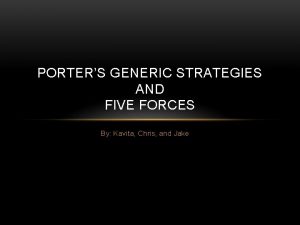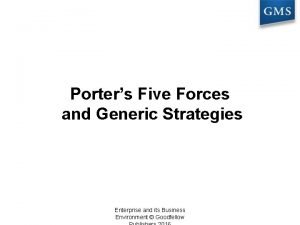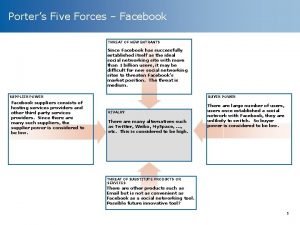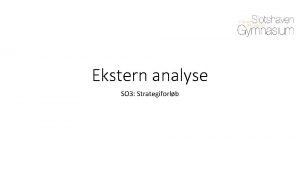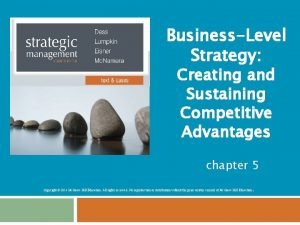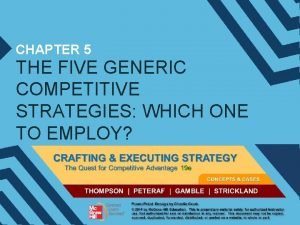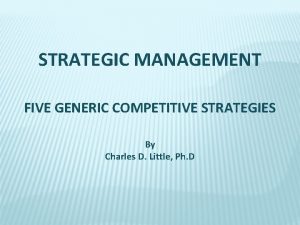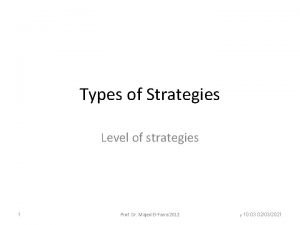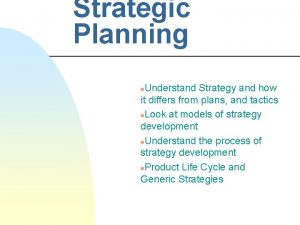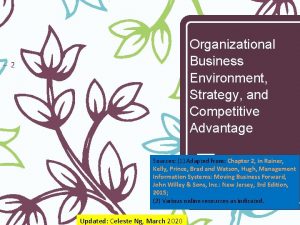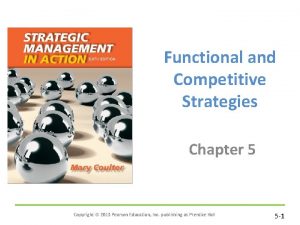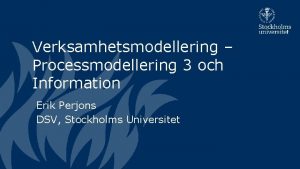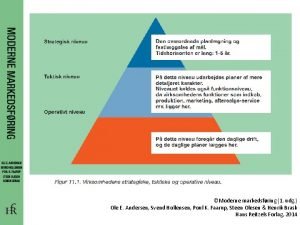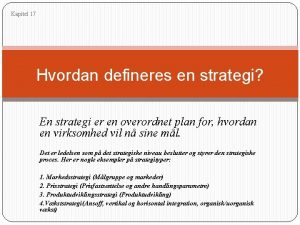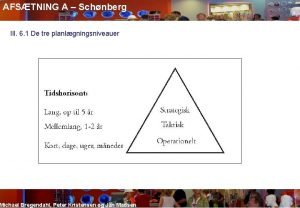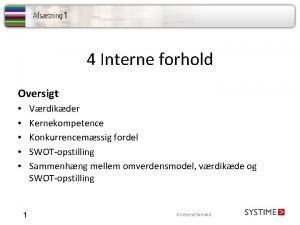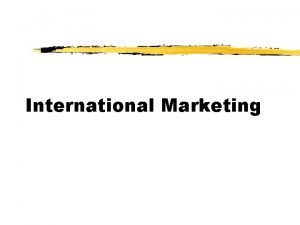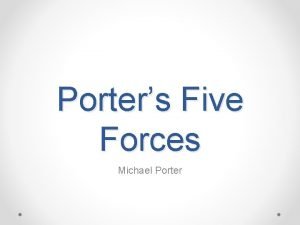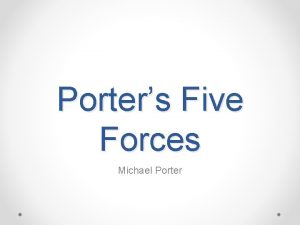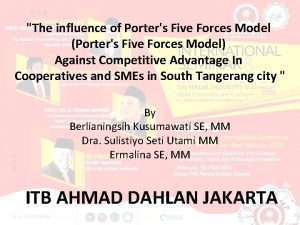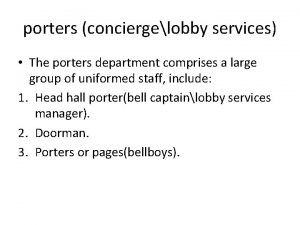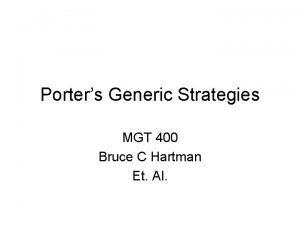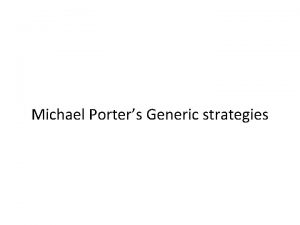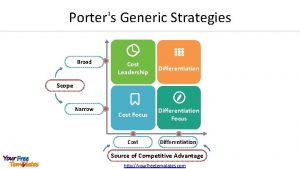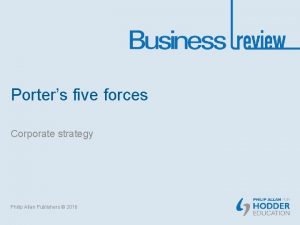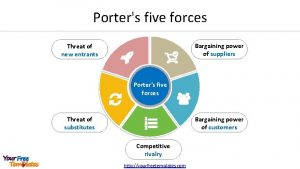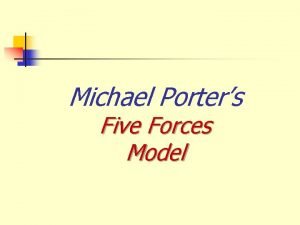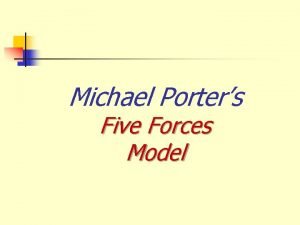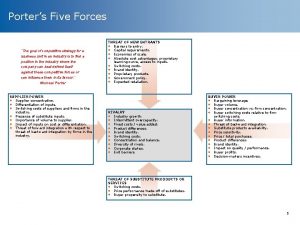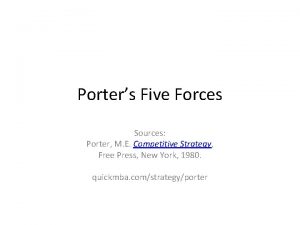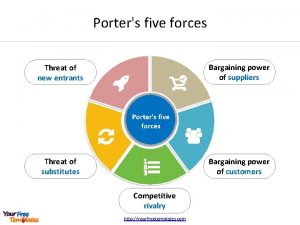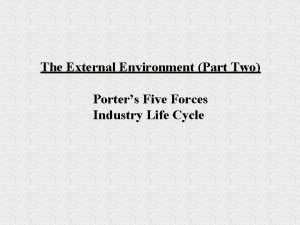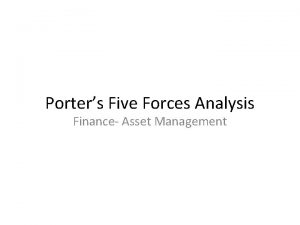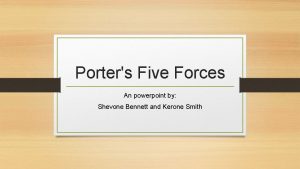Porters Five Forces and Generic Strategies Enterprise and





























- Slides: 29

Porter’s Five Forces and Generic Strategies Enterprise and its Business Environment © Goodfellow

What is the need? • Growth in globalised competition • To ensure competitive advantage • Porter (1980) argues that by understanding “the competitive forces, and their underlying causes, reveals the roots of an industry’s current profitability while providing a framework for anticipating and influencing competition (and profitability) over time. ” Enterprise and its Business Environment © Goodfellow

What are the five forces? • The five forces model is based on theory of determining the competitive intensity and attractiveness of a market • The key five forces involve: • The ease of entry (dependent upon entry barriers), • The power of buyers, • Suppliers, whereby the bargaining power of each group influences profitability, the availability of, • Substitutes which could potentially include alternatives for consumers, and the degree of, • Rivalry among competitors. Enterprise and its Business Environment © Goodfellow

What are the five forces? Enterprise and its Business Environment © Goodfellow

What are the five forces? nsights and attributes into competitive industries: • It implied micro-economic theory into just 5 major influences. • It effectively and before its time applied ‘systems thinking’. • It showed how ‘competitive rivalry’ is very much a function of the other four forces. • It helped predict the long-run rate of returns in a particular industry. • It went beyond a more simplistic focus on relative market growth rates in determining industry attractiveness. • It helped combine input-output analysis of a specific industry with industry boundaries via entry barriers and substitutes. • It emphasized the importance of searching for imperfect markets, which offer more national opportunities for superior returns. Enterprise and its Business Environment © Goodfellow

Competitive Rivalry Enterprise and its Business Environment © Goodfellow

Competitive Rivalry • One of the most important • Increase in pressure, time and cost! • Factors • • Number of Competitors Market Size Product differentiation Power of buyers Capacity utilisation Cost structure Exit barriers Enterprise and its Business Environment © Goodfellow

Competitive Rivalry • Benefits • Differentiation • Research and Development • Lowers prices • Economic growth Enterprise and its Business Environment © Goodfellow

The threat of entry Enterprise and its Business Environment © Goodfellow

The threat of entry • Involves organisations entering into an industry whereby they will gain market share and competition will intensify • Six barriers to entry • • Economies of scale Product differentiation – Loyalty (Shugan, 2005) Capital Requirements Cost disadvantages • • • Raw materials Favorable locations Government subsidies • Distribution channels (Grimm, 2006) Enterprise and its Business Environment © Goodfellow

Buying power Enterprise and its Business Environment © Goodfellow

Buying power • • Customers who collectively become a powerful group Exert pressure Drive down prices Increase the quality of good Enterprise and its Business Environment © Goodfellow

Buying power • Determinants • • Bought in large values of quantity Product or service is standard or undifferentiated Buyer is large and supplier is small Threats of vertical integration • Increases pressure to meet demands Enterprise and its Business Environment © Goodfellow

Supplier power Enterprise and its Business Environment © Goodfellow

Supplier power • The suppliers have power to sell their products at higher prices. • Example: Fast Food Restaurants Enterprise and its Business Environment © Goodfellow

Supplier power • The fundamental bases of supplier power over buyers (Cox, 2001) Enterprise and its Business Environment © Goodfellow

Threat of substitutes Enterprise and its Business Environment © Goodfellow

Threat of substitutes • “A substitute performs the same or a similar function as an industry’s product by a different function. . . [and] limit an industry’s profit potential by placing a ceiling on prices” (Porter, 2008: 84). • Extent depends on: • Switching costs • Product price • Product quality Enterprise and its Business Environment © Goodfellow

Reviewing the five forces Harvard Business Review https: //hbr. org/video/3590615226001/the-explainer-portersfive-forces Enterprise and its Business Environment © Goodfellow

Criticisms of the Five Forces • Does not assist firms to identify and leverage unique sustainable advantages (Speed, 1989). • Focuses on attractiveness of industries rather how firms gain an advantageous position • Overemphasises competition and lack of cooperation • Cannot generalise. Based on a snap shot of time Given these criticisms it is worth mentioning that it has been suggested that “each of Porter’s five forces offers a useful ‘window’ onto industry dynamics” (Mac. Intosh and Mac. Lean, 2015: 64). Enterprise and its Business Environment © Goodfellow

Porter’s Generic Strategies • For organisations to survive and succeed they need to adopt a competitive strategy • Based on gaining competitive advantage • Gaining advantage through better value, price or benefits Enterprise and its Business Environment © Goodfellow

Porter’s Generic Strategies Enterprise and its Business Source: Adapted from Porter (1985: 12). Environment © Goodfellow

Cost Leadership • Focuses on gaining competitive advantage by having the lowest cost in the industry • Aim • To service mass market • Techniques • • • Mass production Mass distribution Economies of scale Technology Product design Enterprise and its Business Environment © Goodfellow

Differentiation • Concentrates on providing a unique product or service, developing a unique selling point (USP) to ensure they are different from their competitors • Tailoring to individual customer segments • Techniques • Extra features • Quality • Price Enterprise and its Business Environment © Goodfellow

Focus/Differentiation Focus • Concentrates on a selected few target markets (focus) or seeks differentiation in its target segment • Aim • Gain a competitive advantage through effectiveness rather than efficiency • Techniques • Being clear in differences with competition • Being clear in differences with other consumers • Niche status Enterprise and its Business Environment © Goodfellow

‘Stuck in the middle’ • Attempt to adopt all three of these strategies • Demonstrates indecisiveness on competitive strategy • Lack of clarity Enterprise and its Business Environment © Goodfellow

Criticisms: Porter’s generic strategies • Theoretical shortcomings • Too general. Simplistic strategy • Fit with reality • Clash with empirical reality • Limited market knowledge • Limited applicability • Not applicable for small firms/ fragmented markets / retailers • Alternative theatrical approaches • Should apply a resource – based approach • Process is flexible Enterprise and its Business Environment © Goodfellow

Further reading • Porter, M. E. (1985). Competitive Advantage. New York: Free Press. • Porter, M. E. (1998). Competitive Strategy. New York: Free Press. • Porter, M. E. (1996). What is strategy? Harvard Business Review 74(6), 61 -78. Enterprise and its Business Environment © Goodfellow

References • Cox, A. (2001). Understanding buyer and supplier power: a framework for procurement and supply competence. Journal of Supply Chain Management, 37(1), 8 -15. • Garau, C. (2007). Porter’s generic strategies: a re-interprettion foma realtiosnship marketing perspective. The Marketing Review 7(4), 369 -383. • Grimm, H. (2006). “Entrepreneurship Policy and Regional Economic Growth: Exploring the Link and Theoretical Implications. ” In Rihoux, B. and Grimm, H. (eds. ) Innovative Comparative. Methods for Policy Analysis Beyond the Quantitative-Qualitative Divide USA: Springer. • Mac. Intosh, R. and Mac. Lean, D. (2015). Strategic Management: Strategists At Work. London: Palgrave Macmillan. • Porter M. E. (1980). Competitive Strategy. New York: Free Press. • Porter, M. E. (1979). How Competitive Forces Shape Strategy. Harvard Business Review 57(2), 137 -145 • Porter, M. E. (1985). Competitive Advantage. New York: Free Press. • Porter, M. E. (2008) The five competitive forces that shape strategy. Harvard Business Review 86(1), 25 -40. • Shugan, S. M. (2005). Brand Loyalty Programs: Are They Shams? Marketing Science 24(2), 185 -193 • Speed, R. J. (1989). Oh Mr Porter! A re-appraisal of competitive strategy. Marketing Intelligence & Planning 7(5/6), 8 -11. Enterprise and its Business Environment © Goodfellow
 Porter's five generic strategies
Porter's five generic strategies Supplier power.
Supplier power. Porter's generic business strategies
Porter's generic business strategies Porters 5 forces facebook
Porters 5 forces facebook Styrkevurdering synonym
Styrkevurdering synonym Creating and sustaining competitive advantage
Creating and sustaining competitive advantage Five generic strategies
Five generic strategies Five generic competitive strategies examples
Five generic competitive strategies examples Types of generic strategies
Types of generic strategies Generic strategies examples
Generic strategies examples Porter’s generic strategies
Porter’s generic strategies Mintzberg generic competitive strategies
Mintzberg generic competitive strategies Flödesenhet synonym
Flödesenhet synonym Moderne markedsføring
Moderne markedsføring Omkostningsleder
Omkostningsleder Porters generiske strategier
Porters generiske strategier De 4 p'er
De 4 p'er Værdikæde handelsvirksomhed
Værdikæde handelsvirksomhed Porter attitudes
Porter attitudes Verksamhetsmodellering
Verksamhetsmodellering Six generic administrative functions
Six generic administrative functions Resultant of unlike parallel forces
Resultant of unlike parallel forces Contact and noncontact forces
Contact and noncontact forces Balanced forces and unbalanced forces venn diagram
Balanced forces and unbalanced forces venn diagram Are canyons constructive or destructive
Are canyons constructive or destructive Multidomestic orientation
Multidomestic orientation The forces shown above are pushing/pulling forces
The forces shown above are pushing/pulling forces Intramolecular vs intermolecular
Intramolecular vs intermolecular Inter vs intramolecular
Inter vs intramolecular Inter vs intramolecular forces
Inter vs intramolecular forces
